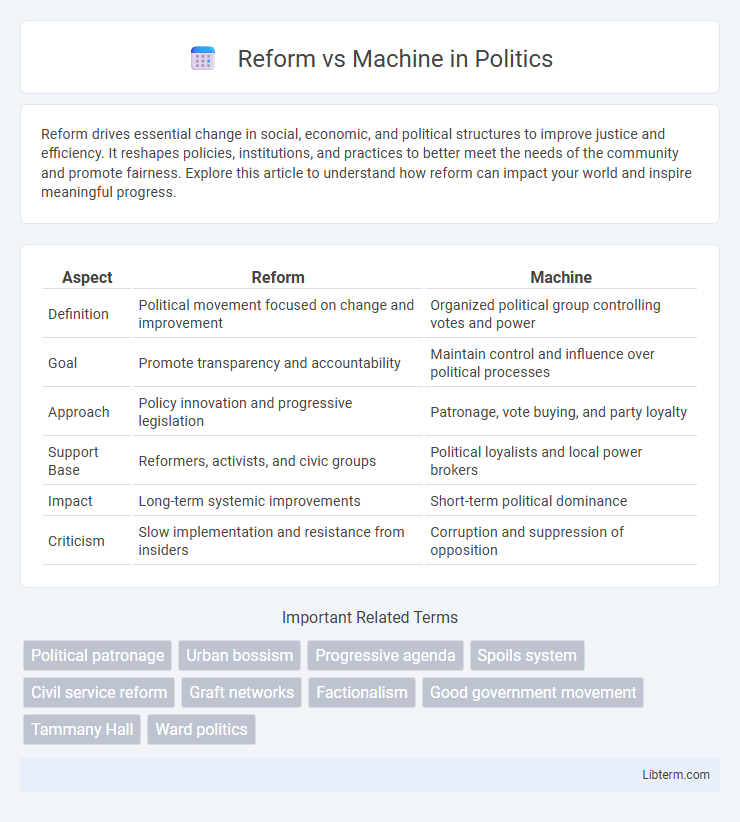Reform drives essential change in social, economic, and political structures to improve justice and efficiency. It reshapes policies, institutions, and practices to better meet the needs of the community and promote fairness. Explore this article to understand how reform can impact your world and inspire meaningful progress.
Table of Comparison
| Aspect | Reform | Machine |
|---|---|---|
| Definition | Political movement focused on change and improvement | Organized political group controlling votes and power |
| Goal | Promote transparency and accountability | Maintain control and influence over political processes |
| Approach | Policy innovation and progressive legislation | Patronage, vote buying, and party loyalty |
| Support Base | Reformers, activists, and civic groups | Political loyalists and local power brokers |
| Impact | Long-term systemic improvements | Short-term political dominance |
| Criticism | Slow implementation and resistance from insiders | Corruption and suppression of opposition |
Understanding Political Reform and Machine Politics
Political reform aims to increase transparency, accountability, and democratic participation by dismantling entrenched machine politics known for patronage and corruption. Machine politics relies on centralized control and loyal voter blocs to maintain power, often undermining electoral fairness and policy innovation. Understanding the dynamics between reform efforts and machine politics reveals challenges in achieving genuine political change within entrenched systems.
Historical Origins of Political Machines
Political machines originated in the late 19th century as organized groups controlling local governments through patronage and corruption, often led by powerful party bosses like New York's Boss Tweed. Reform movements emerged as a response, aiming to dismantle these machines by promoting transparency, civil service exams, and reducing the influence of spoils systems. The historical tension between political machines and reformers shaped urban governance, influencing policies and election dynamics in major American cities.
Key Characteristics of Reform Movements
Reform movements emphasize gradual change through legal and political processes to address social, economic, or political inequalities, often advocating for expanded rights, improved labor laws, and increased government accountability. These movements prioritize peaceful protest, policy advocacy, and grassroots mobilization to influence legislation and public opinion. Unlike revolutionary or violent upheavals, reform efforts seek to work within existing institutional frameworks to create sustainable and measurable improvements in society.
The Power Structure of Political Machines
Political machines wield power through hierarchical networks that control voter loyalty and manipulate elections, often utilizing patronage and patron-client relationships. Reform movements challenge these structures by promoting transparency, merit-based appointments, and electoral reforms aimed at reducing corruption. The power structure of political machines is deeply entrenched in local governance, where machine bosses exert influence over public services and political appointments to maintain control.
Reform vs Machine: Goals and Motivations
Reform movements aim to address social, political, or economic issues through gradual improvements and policy changes that enhance fairness, justice, and representation. Machine politics, often driven by powerful party organizations, prioritize maintaining control, loyalty, and electoral dominance through patronage and mobilization networks. The motivations behind reform focus on systemic change and public welfare, whereas machine politics seek to consolidate power and influence within a defined political structure.
Influence on Voter Participation and Democracy
Reform-driven political systems often enhance voter participation by promoting transparency, reducing barriers to voting, and encouraging civic engagement, leading to stronger democratic practices. In contrast, machine politics can suppress voter turnout through patronage, manipulation, and limited accountability, weakening democratic institutions. Empirical studies show regions with reform-based governance experience higher electoral participation rates and improved public trust compared to areas dominated by political machines.
Case Studies: Famous Reformers and Machine Bosses
Case studies of famous reformers like Robert La Follette highlight efforts to dismantle political machines by promoting transparency and direct democracy. Contrastingly, machine bosses such as William M. Tweed utilized patronage and control over local elections to maintain power and influence urban politics. These case studies illustrate the dynamic tension between reform-driven governance and entrenched political machine structures.
Corruption and Accountability in Machine Politics
Reform movements target the entrenched corruption and lack of accountability typical of machine politics, where powerful political machines manipulate votes and public resources to maintain control. Machine politics often thrive on patronage and nepotism, undermining transparent governance and eroding public trust. Efforts to introduce reforms focus on ethical standards, transparent electoral processes, and mechanisms for holding officials accountable to dismantle these corrupt networks.
Long-term Impacts of Reform Initiatives
Reform initiatives often aim to address systemic inefficiencies and promote sustainable development, resulting in long-term economic growth and social equity. In contrast, machine-driven solutions primarily optimize immediate operational efficiencies but may lack adaptability to evolving human and environmental needs over time. Sustainable reforms tend to foster inclusive progress by integrating policy changes with technological advancements, ensuring resilience against future challenges.
The Future of Political Reform and Machine Dynamics
Political reform efforts often clash with entrenched machine dynamics that prioritize maintaining power through patronage and controlled networks. The future of political reform hinges on leveraging technology and grassroots mobilization to disrupt traditional machine influence, promoting transparency and accountability. Emerging digital platforms enable more direct voter engagement and real-time oversight, potentially reshaping the landscape of political power structures.
Reform Infographic

 libterm.com
libterm.com